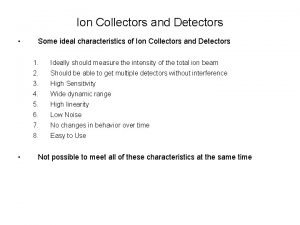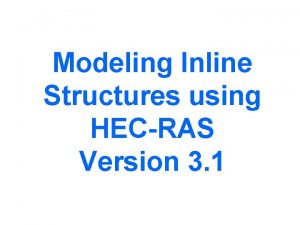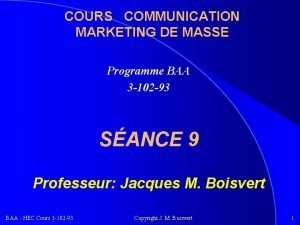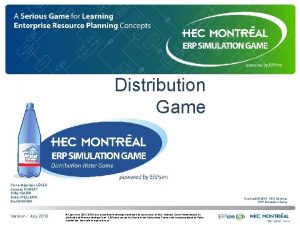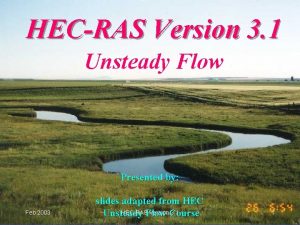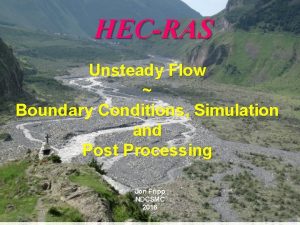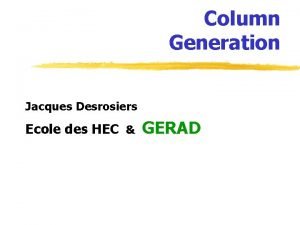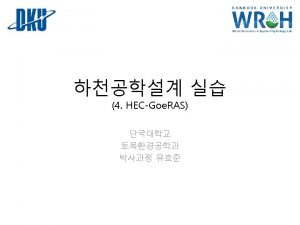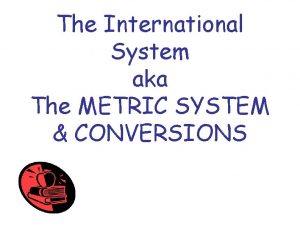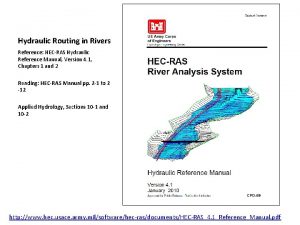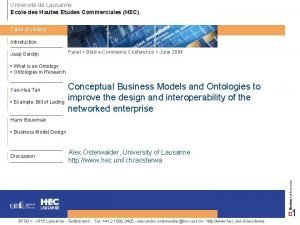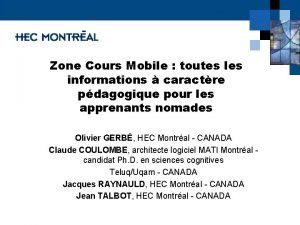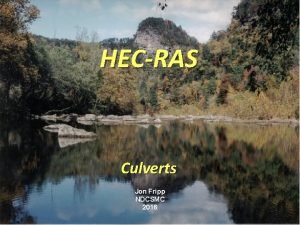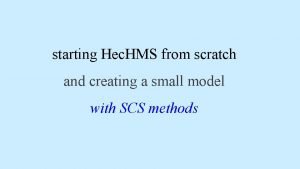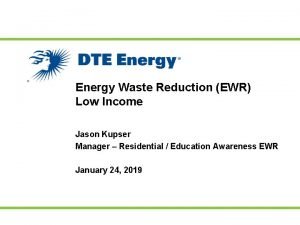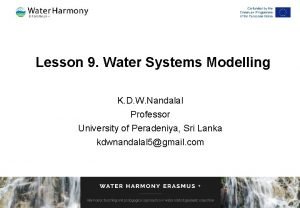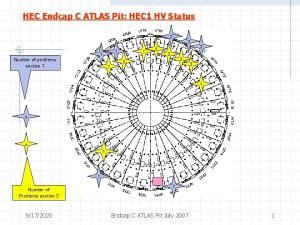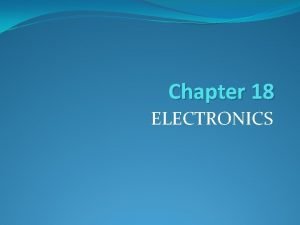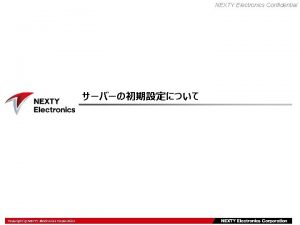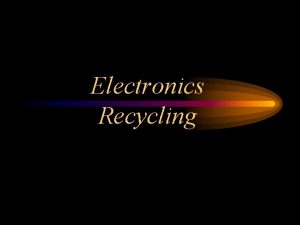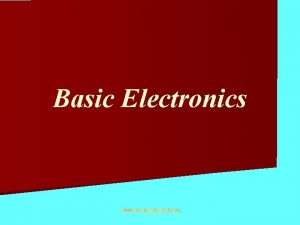HEC Cold Electronics Ga As IC 8 preamplifier






















- Slides: 22

HEC Cold Electronics Ga. As IC: 8 preamplifier channels 2 summing amplifiers PSB boards with IC‘s are mounted at the outer circumference of the HEC wheels; 1/15/2022 HEC: Upgrade of Cold Electronics - February 2009, P. Schacht 1

HEC Cold Electronics PSB boards Concept of ‘active pads‘, i. e. signals from (2/4/8/16) pads are amplified and summed (ASIC) to the required output signals in cold ; Optimal signal to noise ratio; Technology chosen: Ga. As Tri. Quint QED-A 1 m; excellent high frequency performance, stable operation at cryogenic temperatures, radiation hardness; For upgrade PSB boards would be replaced with pin-compatible new boards with new IC’s; this can be done at the outer circumference of a HEC wheel without rotating and disassembling the wheel 1/15/2022 HEC: Upgrade of Cold Electronics - February 2009, P. Schacht 2

HEC Cold Electronics: replacement Huge task to replace all PSB boards of all HEC wheels in rather short time (18 months, including warm-up/cool-down): de-cable and re-cable again with all the required QC tests as have been done in B 180 (in substantial longer time period); All actions need to be done in the ATLAS pit; Endcap calorimeters including PSB boards are ‘nuclear waste material’: special procedures for handling and safety operations required to keep the exposure to radiation below the legal limits; Major engineering task in terms of tooling, work flow and workload optimization; 1/15/2022 HEC: Upgrade of Cold Electronics - February 2009, P. Schacht 3

HEC Cold Electronics: Radiation Hardness Seven chips exposed to total neutron fluence (fast) of up to 1. 11 1015 n/cm 2; Eight chips exposed to total dose of 55 k. Gy; ATLAS: expect in 10 years neutron fluence of 0. 2 1014 n/cm 2 ; Degradation of performance sets in at typically 3 1014 n/cm 2 ; 1/15/2022 HEC: Upgrade of Cold Electronics - February 2009, P. Schacht 4

HEC R & D plans: new, more radiation hard IC‘s Radiation hardness up to a factor of 10 better, i. e. up to neutron fluence of few 1015 n/cm 2; Low power consumption (avoid boiling LAr HV !!!), do not exceed present level of < 0. 2 W; Gain variation between warm and cold not more than a factor of 2, because most QC tests have to be done in warm; this is a particular difficult requirement as applicable technologies model calculations exist only down to -40 C; Low noise, should not exceed present level; Gain variation of individual preamplifier channels has to stay in one IC below 1% (calibration of the total channel only!); IC has to be safe with respect to potential HV discharges in the gaps of the HEC calorimeter; 1/15/2022 HEC: Upgrade of Cold Electronics - February 2009, P. Schacht 5

HEC: Specification of new cold electronics Radiation hardness (10 years s. LHC): : 50 k. Gy; n: 1. 5 1015 n/cm 2; p: 1. 2 1012 p/cm 2 1/15/2022 HEC: Upgrade of Cold Electronics - February 2009, P. Schacht 6

Study of radiation hardness of various technologies – irradiate specific transistors in n-beam IHP (pnp is not consid ered) SGB 25 V 250 nm Si. Ge Si Ga. As Bipolar HBT CMOS FET IBM 8 WLBi. CMO S 130 nm - MB npn 0. 84*0. 42 (+ ESD) AMS Bi. CMOS 130 nm Sirenza ? IHP SGB 25 V 250 nm amplifier npn nmos pmos 0. 12*1*2 (H) SBC 3 0, 35*2, 4 SGA-8343 350*0. 24 (n 1) 350*0. 24 (p 1) 0. 12*12*2 (K) SBC 30 0, 35*24 SGA-8543 750*0. 24 (n 2) 750*0. 24 (p 2) 0. 12*3*4 (L) SBC 300 0, 35*96 Material Transistor Triquint Sirenza producer CFH 800 250 nm (? ) 250 nm Process p. HEMT 800*0. 4 Type 600*0. 5 (T 1) Size(µm 2) 300*0. 25 (T 2) 0. 12*8*1 (M) 0. 12*16*6 (P) 1/15/2022 HEC: Upgrade of Cold Electronics - February 2009, P. Schacht 7

Measurements at Rez: set-up Testboard 10*8 cm 2 Example: IHP transistors: four structures (2 n, 2 p) are bonded in this ceramic package; 1/15/2022 HEC: Upgrade of Cold Electronics - February 2009, P. Schacht 8

Network analyzer: S-parameter measurement Measurement of reflected and incident voltages; Measurement is done at a reference impedance (50 Ω); Measurements are done in frequency domain (value, phase) → full description of device to be studied; Broad frequency range (up to few GHz); 1/15/2022 HEC: Upgrade of Cold Electronics - February 2009, P. Schacht 9

Measurements at Rez: set-up 1/15/2022 HEC: Upgrade of Cold Electronics - February 2009, P. Schacht 10

Measurements at Rez: set-up Testing up to 37 devices (transistors); Measuring DC values and Sparameters; Measuring during neutron irradiation; 1/15/2022 HEC: Upgrade of Cold Electronics - February 2009, P. Schacht 11

Neutron Irradiation at Rez/Prague: Set-up: typically 10 boards aligned in n-beam p-beam Deuterium target 1/15/2022 HEC: Upgrade of Cold Electronics - February 2009, P. Schacht 12

Neutron Irradiation at Rez/Prague: Neutron flux for different slots and energy spectrum 1/15/2022 HEC: Upgrade of Cold Electronics - February 2009, P. Schacht 13

HEC Cold Electronics – online monitoring from Rez run Event # 151 Total flux Event # 151 × 1015 Event # 151 U/I Total flux × 1015 temperature × 1015 Total flux × 1015 Example: IHP Si. Ge Bipolar – slot 1 … last ‘event‘ …. 1/15/2022 HEC: Upgrade of Cold Electronics - February 2009, P. Schacht × 1015 Total flux up to 2. 2 · 1015 14

Results example: Ga. As p. HEMT (Sirenza): 600*0. 5 (T 1), 300*0. 25 (T 2) Slot 4 Slot 10 2 · 1014 cm-2 1/15/2022 2 · 1015 cm-2 HEC: Upgrade of Cold Electronics - February 2009, P. Schacht 15

Results Loss of gain (%) at integrated n-flux of 2 · 1014 cm-2 Si. Ge Si Ga. As Bipolar CMOS FET IHP IBM Sirenza 0% 0% 0% 0. 5% 0% -5% 5% 0% 0% 1/15/2022 IHP nmos pmos Material Type of Transistor Triquint Sirenza 0% 0% 1% (1) -1% (2) 0. 5 MHz 0% 0% 0% 1% (1) -2% (2) 10 MHz 0% 0. 5% 1% 0% 0. 5% (1) -0. 5% (2) 40 MHz 0% 0% 0% 2% 3% (1) -1% (2) HEC: Upgrade of Cold Electronics - February 2009, P. Schacht producer 90 MHz 16

Results Loss of gain (%) at integrated n-flux of 2 · 1015 cm-2 Si. Ge Si Ga. As Bipolar CMOS FET IHP IBM Sirenza -15% 0% 0% 1% (1) 3% (2) 5% 5% 15% 3% 2% 2% 3% 15% 20% IHP nmos pmos Material Type of Transistor Triquint Sirenza 1% -1% 2% (1) -4% (2) 0. 5 MHz 2% (1) 4% (2) 4% 0% 4% (1) -5% (2) 10 MHz 0. 5% (1) 3. 5% (2) 3% 3. 5% (1) -1. 5% (2) 40 MHz @1. 2· 1015 1% 3% 10% 8% @1. 2· 1015 2% producer 90 MHz @1. 2· 1015 1/15/2022 HEC: Upgrade of Cold Electronics - February 2009, P. Schacht 17

Results Loss of gain (%) at maximum integrated n-flux reached for the specific device Si. Ge Si Ga. As Bipolar CMOS FET IHP IBM Sirenza @2. 2· 1016 @3. 6· 1015 @2· 1015 40% 0% 0% 6% (1) 11% (2) 80% 15% 75% 11% 75% 1/15/2022 IHP @8· 1015 nmos pmos Material Type of Transistor Triquint Sirenza @1. 2· 1015 @2· 1015 7% -1% 2% (1) -4% (2) 0. 5 MHz 5% (1) 10% (2) 10% 0% 4% (1) -5% (2) 10 MHz 15% 4% (1) 11% (2) 11% 2% 3. 5% (1) -1. 5% (2) 40 MHz 20% 8% 11% 10% 8% 90 MHz HEC: Upgrade of Cold Electronics - February 2009, P. Schacht producer 18

Results: DC measurements Si. Ge DC measurements ('Gummel plots') before and after irradiation: measure base & collector currents for different UBE ; Example: IHP Si. Ge bipolar without irradiation; Current gain IC/IB !!! 1/15/2022 HEC: Upgrade of Cold Electronics - February 2009, P. Schacht 19

Results: DC measurements Current gain IC/IB; Si. Ge - Bipolar HBT Material IHP IBM Sirenza producer 182 131 176 (IC/IB)Max (UBE=0. 6 V, IB= 0. 16 n. A) (UBE=0. 67 V, IB= 49 n. A) (UBE=0. 66 V, IB= 3. 2µA) Voltage & base current @ 8· 1014 cm-2 @ 4· 1014 cm-2 @ 3· 1014 cm-2 Radiation Level 149 95 114 (IC/IB)Max (UBE=0. 78 V, IB= 0. 15µA) (UBE=0. 8 V, IB= 3. 1µA) (UBE=0. 66 V, IB= 13. 3µA) Voltage & base current @ 2· 1015 cm-2 Radiation Level 55 (IC/IB)Max (UBE=0. 68 V, IB= 0. 91 m. A) (current limit) Voltage & base current @ 2. 3· 1016 cm-2 16 (UBE=0. 84 V, IB= 12µA) 1/15/2022 @ 3. 7· 1015 cm-2 72 (UBE=0. 87 V, IB= 33µA) HEC: Upgrade of Cold Electronics - February 2009, P. Schacht 20

Results: Dependence of gain on temperature Gain at room temperature is 100%; Si. Ge Si Ga. As Material Bipolar CMOS FET Type of Transistor IHP IBM Sirenza 0 0 0 +1, 7% 0 0 0 1/15/2022 IHP nmos pmos Triquint Sirenza producer +4, 2% +3. 1% +86% Gain at 0. 5 MHz (-196°C) +2% +11% +3. 6% +89% Gain at 10 MHz (-196°C) +11, 6% +27. 5% -56% -4, 2% Collector current (-196°C) HEC: Upgrade of Cold Electronics - February 2009, P. Schacht 21

HEC Cold Electronics -Conclusions Summary from 'Mini Review‘ February 12/13 th at MPI: n Radiation hardness of technologies studied OK for HEC; n Si CMOS FET & Ga. As FET more stable with temperature; n Bipolar technologies: strong dependence on temperature, operation point needs adjustment for temperature dependence; n CMOS: maybe problems with line driver with dynamic range – to be tested; n γ-irradiation: needs to be looked at, but lower priority; Next steps: n One more irradiation run with AMS transistors; n Modify set-up at Rez to allow for irradiation in cold; more studies on n-flux (energy and radial dependence) n Study 2 -3 options simulating HEC preamp+summing amplifier; n Design/test PA+SA using transistors+external components; n Design full chip Goal: Have full chip ready for 2010 (? ). In parallel: n Design new PSB board n Investigate installation at ATLAS n Prepare new (more rad. hard) LV system 1/15/2022 HEC: Upgrade of Cold Electronics - February 2009, P. Schacht 22
 Charge sensitive preamplifier
Charge sensitive preamplifier Channeltron preamplifier definition
Channeltron preamplifier definition Masthead preamplifier
Masthead preamplifier The cold war begins lesson 1
The cold war begins lesson 1 Hec ras inline structure
Hec ras inline structure Hec baa
Hec baa Jacques robert hec
Jacques robert hec Usda hec grant
Usda hec grant Hec ras cross section spacing
Hec ras cross section spacing Hec-ras boundary conditions
Hec-ras boundary conditions Hec
Hec Des hec
Des hec Hec usace army mil
Hec usace army mil Système impérial
Système impérial Hec ras reference manual
Hec ras reference manual Chec certification
Chec certification Hec 25
Hec 25 Hec unil resultats
Hec unil resultats Zone cours hec
Zone cours hec Modeling long culverts in hec-ras
Modeling long culverts in hec-ras Index flow hec hms
Index flow hec hms Dte home energy consultation
Dte home energy consultation Hec ressim
Hec ressim

